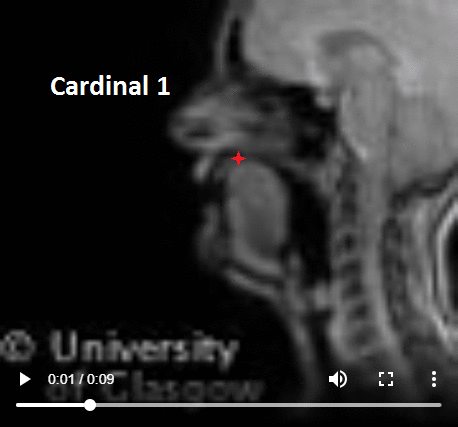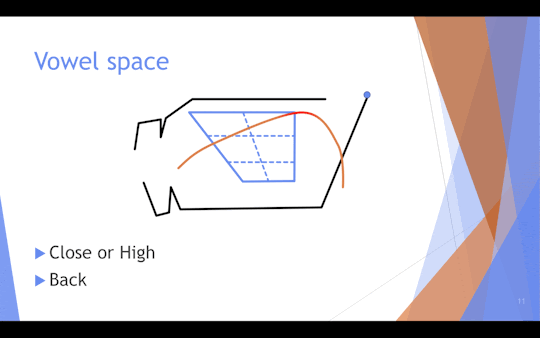The acoustic phenomena we perceive as vowel sounds are created by shapes in the vocal tract. The primary articulator variables that shape the vocal tract and control vowel quality are:
- Tongue body height;
- Tongue body frontness/backness;
- Lip rounding or lack of lip rounding.
The MRI animation below shows one individual’s tongue and lips moving quickly through a series of vowel shapes/sounds called “cardinal” vowels. These are a series of theoretically equi-distant tongue positions that delineate the bounds of the vowel space–the highest and lowest, frontest and backest tongue body positions that will produce an unobstructed vocal tract resonance configuration–a vowel sound (vs. an airstream stricture in the vocal tract, which will produce a consonant sound).
It’s important to remember that these vowels are not necessarily the vowels we use in language. They are simply a series of possible physical/acoustic configurations that may or may not map onto some of the vowels each of us uses in our native language. They are physical/acoustic landmarks, and the vowels we hear and use in language can be situated in relationship to them.

The animation below shows a similar range of movements in schematic form. The highest point of the red line representing the tongue traces a blue quadrilateral shape as it moves around the vocal tract. This shape can be called the “vowel space”.

Here we see a series of MRI images representing cardinal vowel shapes superimposed on a vowel space quadrilateral. International Phonetic Alphabet (IPA) symbols representing these cardinal vowel shapes/sounds are also shown.

For an interesting look at the ways articulatory and acoustic phonetics differ in their conceptualization of the vowel space, please see Dr. Geoff Lindsey’s excellent article on the vowel space (includes clickable synthesized audio).
For a physical exercise to explore kinesthetic awareness of vocal tract vowel shaping, please see my article in the Voice & Speech Review: Exercise Essay: Vowel Yoga
Another useful visualization tool is this Vowel Demonstrator. This unfortunately isn’t available as a web app, but can be installed on Windows/Mac machines.